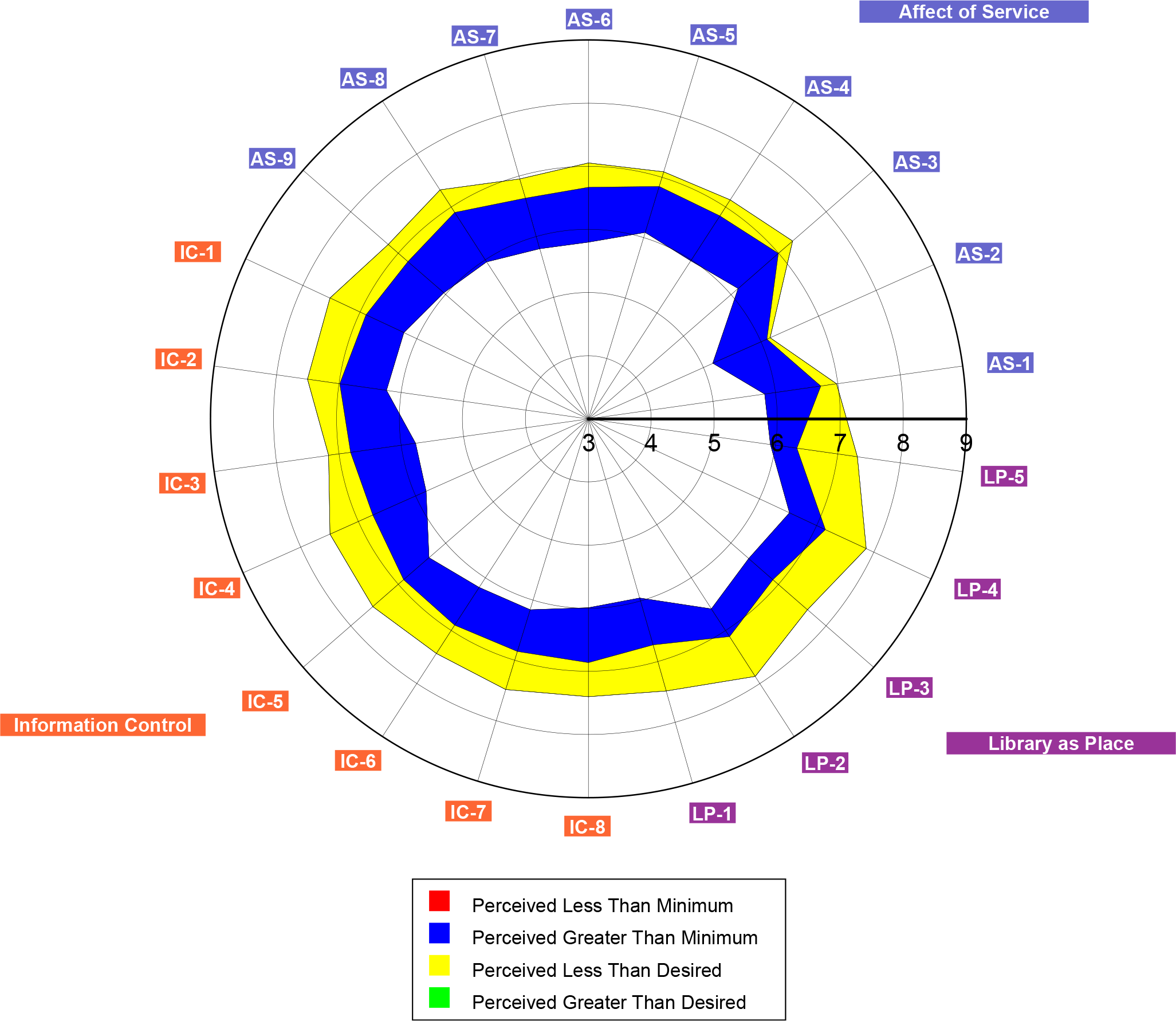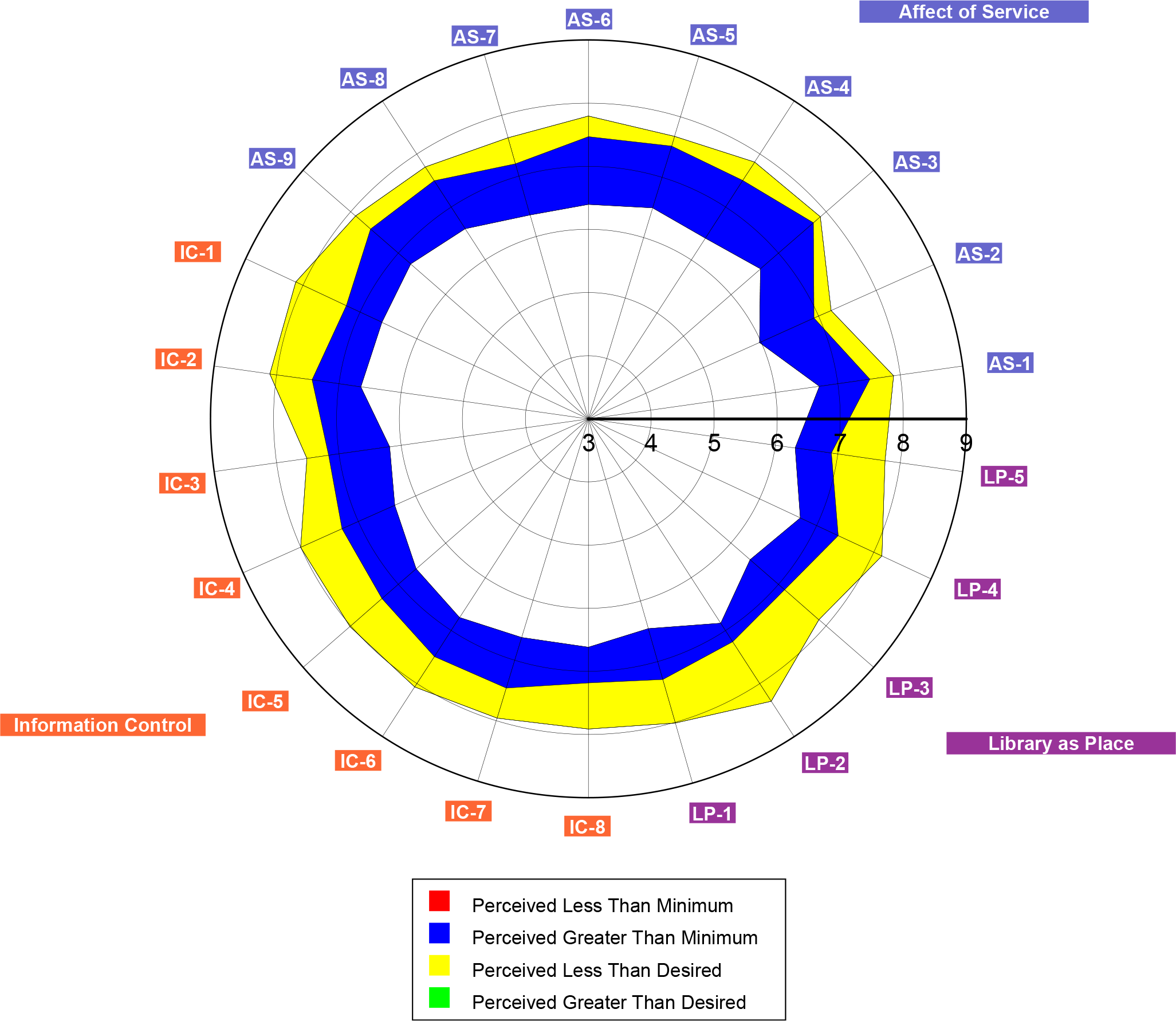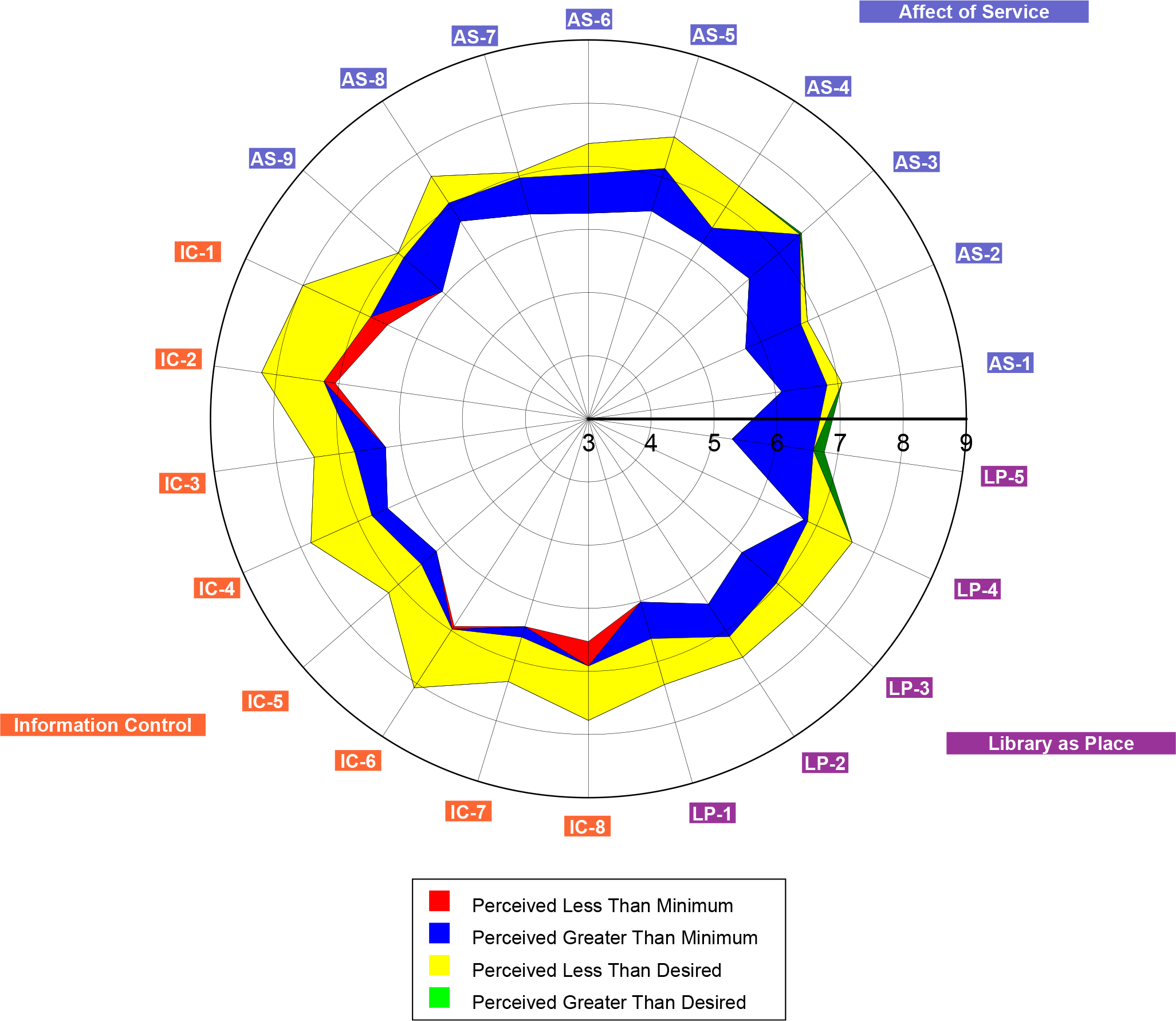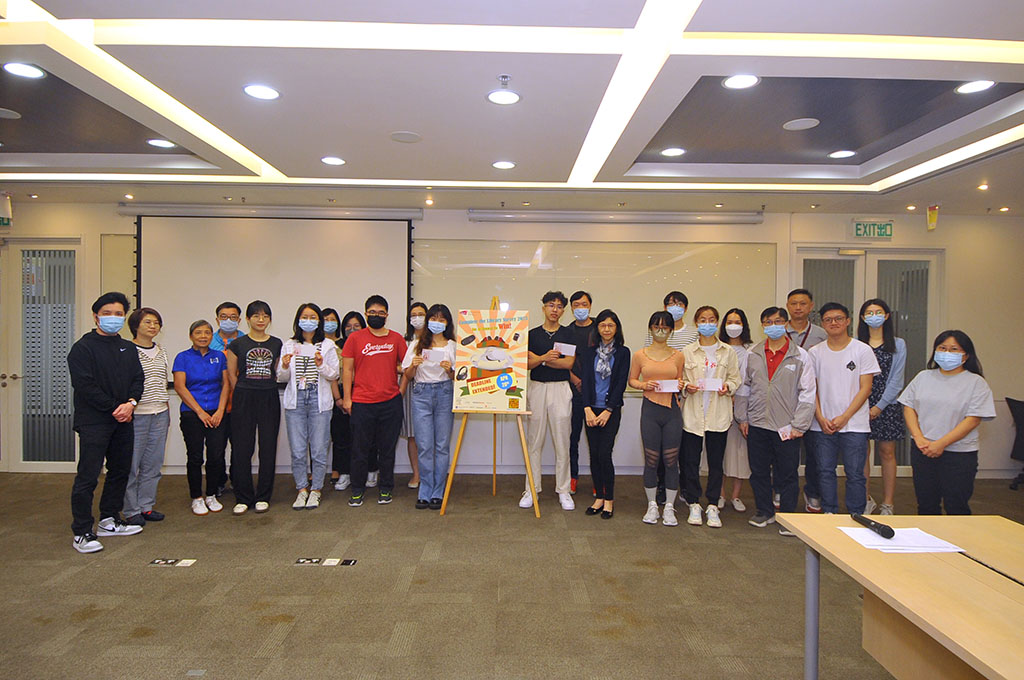User Survey
Thank you all for participating in the Library User Survey 2023 (LibQUAL+®).
To maintain our commitment to providing excellent service to the University community, the Library carried out a survey on the quality of its services from March 15th to April 28th, 2023. The survey was administered to current students, faculty, and staff.
Survey Results
The following presents the main results of the Survey.- Response Rates
- Service Dimensions and Scores
- Core Survey Questions – Result (Undergraduate)
- Core Survey Questions – Result (Postgraduate)
- Core Survey Questions – Result (Academic & Research Staff)
- Core Survey Questions – Result (Staff)
- Prizes
Response Rates
A total of 2,660 respondents participated in the survey. The following breakdown illustrates the number of respondents per user group.| User Group | Respondents |
Respondent % |
Undergraduate |
1,514 |
56.77% |
Postgraduate |
873 |
32.73% |
Academic & Research Staff |
120 |
4.50% |
Staff |
153 |
5.74% |
Service Dimensions and Scores
The survey measures library users’ minimum, perceived, and desired levels of service quality across three dimensions: Affect of Service, Information Control, and Library as Place.- Affect of Service: services provided by library staff
- Information Control: availability of physical and electronic resources.
- Library as Place: physical spaces, facilities, and environment of the library.
There was a total of 22 core survey questions, and for each of these core questions, the respondents provided scores for the following three levels of service on a 9-point Likert scale (1=lowest, 9-highest):
- Minimum level of service: the minimum level of service that library users deem acceptable.
- Desired level of service: the level of service that library users would like to receive.
- Perceived level of service: the current level of service that library users believe is being provided.
Making use of the scores for the minimum, desired and perceived levels of service, the Adequacy Gap and Superiority Gap can be measured.
- Adequacy gap: measured by the “Adequacy Gap Score” which is the difference between the perceived level of service and the minimum acceptable level of service (i.e. Perceived Score minus Minimum Score). The higher the score, the better the library service. A negative score (i.e. Perceived Score is less than the Minimum Score) indicates that the service quality is below the minimum acceptable level.
- Superiority gap: measured by the “Superiority Gap Score” which is the difference between the perceived level of service and the level of service desired by the user (i.e. Perceived Score minus Desired Score). It is an indicator of the extent to which the library service exceeding the users’ desired expectations. A negative number indicates that the library will need to do more to reach the level of service users aspire to receive.
The following sections of the report highlight the significant findings of the survey questions for undergraduate students, postgraduate students, academic and research staff, and staff in general.
The scores for minimum, desired and perceived levels of service quality are plotted on each axis of the corresponding radar chart to show the adequacy and superiority gaps in different colors.
Core Survey Questions – Result (Undergraduate)
Radar Chart:

Interpret the radar chart:
The shape of the polygon suggests that the Library's overall service quality rating is relatively high. Certain areas exhibit notable strengths, such as in the domain of Affect of Service, while other areas present weaknesses, as observed in the Library as Place.
Analyze the results:
Listed below are the three most prominent aspects based on their perceived level, desired level, as well as the gaps in adequacy and superiority.
Perceived Level |
Desired Level |
Adequacy Gap |
Superiority Gap |
|
1 |
LP-4: A haven for study, learning, or research (7.15) |
LP-2: Quiet space for individual work (7.87) |
IC-3: The printed library materials I need for my work (1.04) |
LP-5: Space for group learning and group study (-0.97) |
2 |
LP-2: Quiet space for individual work (7.11) |
LP-4: A haven for study, learning, or research (7.87) |
AS-2: Giving users individual attention (0.94) |
LP-1: Library space that inspires study and learning (-0.76) |
3 |
AS-3: Library staff who are consistently courteous (7.00) |
LP-3: A comfortable and inviting location (7.61) |
AS-8: Willingness to help users (0.93) |
LP-2: Quiet space for individual work (-0.75) |
Core Survey Questions – Result (Postgraduate)
Radar Chart:
Interpret the radar chart:
The shape of the polygon suggests that the Library's overall service quality rating is relatively high. Certain areas exhibit notable strengths, such as in the domain of Affect of Service, while other areas present weaknesses, as observed in the Library as Place.
Analyze the results:
Listed below are the three most prominent aspects based on their perceived level, desired level, as well as the gaps in adequacy and superiority.
Perceived Level |
Desired Level |
Adequacy Gap |
Superiority Gap |
|
1 |
AS-3: Library staff who are consistently courteous (7.74) |
LP-2: Quiet space for individual work (8.33) |
AS-3: Library staff who are consistently courteous (1.11) |
LP-2: Quiet space for individual work (-1.12) |
2 |
AS-9: Dependability in handling users' service problems (7.58) |
LP-4: A haven for study, learning, or research (8.15) |
AS-4: Readiness to respond to users' enquiries (1.09) |
IC-1: Making electronic resources accessible from my home or office (-0.88) |
3 |
AS-5: Library staff who have the knowledge to answer user questions (7.52) |
IC-1: Making electronic resources accessible from my home or office (8.13) |
AS-6: Library staff who deal with users in a caring fashion (1.08) |
LP-5: Space for group learning and group study (-0.86) |
Core Survey Questions – Result (Academic & Research Staff)
Radar Chart:
Interpret the radar chart:
The shape of the polygon suggests that the Library's overall service quality rating is relatively high. Certain areas exhibit notable strengths, such as in the domains of Affect of Service and Library as Place, while other areas present weaknesses, as observed in the Information Control.
Analyze the results:
Listed below are the three most prominent aspects based on their perceived level, desired level, as well as the gaps in adequacy and superiority.
Perceived Level |
Desired Level |
Adequacy Gap |
Superiority Gap |
|
1 |
AS-3: Library staff who are consistently courteous (7.48) |
IC-2: A library Web site enabling me to locate information (8.24) |
LP-5: Space for group learning and group study (1.48) |
IC-1: Making electronic resources accessible from my home or office (-1.48) |
2 |
AS-5: Library staff who have the knowledge to answer user questions (7.15) |
IC-6: Easy-to-use access tools that allow me to find things (8.08) |
AS-3: Library staff who are consistently courteous (1.10) |
IC-8: Print and/or electronic journal collections I require for my work (-1.25) |
3 |
LP-2: Quiet space for individual work (7.12) |
IC-1: Making electronic resources accessible from my home or office (8.00) |
AS-2: Giving users individual attention (0.96) |
IC-2: A library Web site enabling me to locate information in my own (-1.18) |
Core Survey Questions – Result (Staff)
Radar Chart:
Interpret the radar chart:
The shape of the polygon suggests that the Library's overall service quality rating is relatively high. Certain areas exhibit notable strengths, such as in the domains of Library as Place, while other areas present weaknesses, as observed in the Information Control.
Analyze the results:
Listed below are the three most prominent aspects based on their perceived level, desired level, as well as the gaps in adequacy and superiority.
|
Perceived Level |
Desired Level |
Adequacy Gap |
Superiority Gap |
1 |
LP-3: A comfortable and inviting location (7.32) |
IC-2: A library Web site enabling me to locate information (7.65) |
LP-3: A comfortable and inviting location (1.18) |
IC-6: Easy-to-use access tools that allow me to find things on my own (-0.90) |
2 |
LP-4: A haven for study, learning, or research (7.07) |
IC-5: Modern equipment that lets me easily access needed (7.61) |
AS-3: Library staff who are consistently courteous (0.84) |
IC-5: Modern equipment that lets me easily access needed information (-0.86) |
3 |
IC-7: Making information easily accessible for independent use (7.00) |
IC-1: Making electronic resources accessible from my home or office (7.57) |
IC-4: The electronic information resources I need (0.82) |
IC-2: A library Web site enabling me to locate information on my own (-0.74) |
Examples of praises:
- Overall is great. Resources are enough and up-to-date.
- I love the haven provided by the library for students to study, the staff are also very nice and guide students to places that they enquire.
- It is an awesome library with both amazing physical and online resources, particularly appreciate the multitude of online workshops. they are very helpful.
- Searching for books/articles on cityu's library website is very convenient as It even allows users to choose categories for example applying for peer reviewed articles etc.
- Library has a good study atmosphere. Also, library used to be a good location for online lesson. I love library!
- 服務時間足夠,職員友善,令我有良好體驗。
- 我認為城大圖書館設備很齊全,圖書館職員也很好,環境舒服,是個學習的好地方。
Prizes:
- 1x Oculus Quest 2 Virtual Reality Headset
- 1x Bose QuietComfort® 45 Headphones
- 1x Apple Watch SE (40mm)
- 1x Beats Fit Pro True Wireless Earbuds
- 1x Samsung Galaxy Tab A8
- 1x Marshall Minor III True Wireless Earbuds
- 1x JBL Charge 5 BT Speaker
- 1x SONY SRS-NB10 Wireless Neckband Speaker
- 5x HidrateSpark PRO STEEL - 21 oz. Smart Water Bottle + Bonus Straw Lid
- 50x HKD $100 Festival Walk Gift Vouchers
Prizes Presentation Ceremony:







